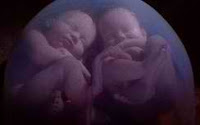Aspergers and Identical Twins
Question
 Out of curiosity, is Aspergers relatively common amongst twins who have been affected by TTTS before birth, specifically the 'donor' sibling? I was thinking of the link with oxygen starvation being the common denominator. Many thanks, by the way love the website/emails!!
Out of curiosity, is Aspergers relatively common amongst twins who have been affected by TTTS before birth, specifically the 'donor' sibling? I was thinking of the link with oxygen starvation being the common denominator. Many thanks, by the way love the website/emails!!
Answer
For those who may not know, TTTS is a disease of the placenta. In a normal multiple birth pregnancy, some blood vessels are shared between the babies and blood flow between them is equal. One minute one baby will act like a donor, the next it will act as a recipient. In a pregnancy with TTTS, for some reason, the blood flow isn't equal between the babies. One baby will always be the donor and the other always the recipient. This causes one baby to be larger than the other.
Having said this, there is no solid research currently that suggests a link between TTTS and Autism Spectrum Disorders. However, new research with rats suggests that “oxygen deprivation” (one byproduct of TTTS) during birth could be a contributing cause of Autism.
There's no easy way to test the oxygen-deprivation theory in humans, and the finding isn't likely to lead to better treatments in the near future. Still, the research gives scientists greater insight into how factors other than genetics may play a role in autism.
Research reveals that when one identical twin develops an Autism Spectrum Disorder (ASD), the risk of the other developing it is substantially higher than it is for fraternal twins (approximately 88% higher). That compared with 31% among fraternal twins (unlike identical twins, fraternal twins are no more genetically similar than non-twin siblings). Identical twins also have greater similarities in the form of the ASD that they developed, their level of day-to-day functioning, and the risk of intellectual impairment.
Autism research has been guided by one important observation for the past several decades – that it has a large genetic component. That observation was made through twin studies. We show that important characteristics of ASD, such as the type of ASD, level of functioning and presence of other psychiatric disorders are more similar among identical twins. Thus not only are they more concordant overall, but the pattern of their disease is more concordant.
While experts generally agree that genetics plays a major role in ASDs, they also believe that environmental factors conspire with genes to make certain children vulnerable. Researchers are still trying to figure out what those environmental factors are.
The Aspergers Comprehensive Handbook


